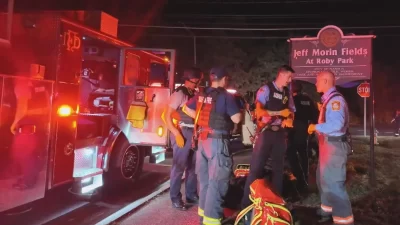
Police used tear gas and flash-bang grenades Monday to halt a march seeking to stop construction of a police and firefighter training center in Atlanta.
More than 500 people on Monday marched about 2 miles (3.2 kilometers) from a park to the site, which is just outside the Atlanta city limits in suburban DeKalb County.
A wedge of marchers, including some in masks, goggles and chemical suits intended to protect against tear gas, pushed into a line of officers in riot gear on a road outside the training center site. Officers pushed back and then responded with tear gas, with one protester throwing a canister back at officers.
Protests against the proposed training center — dubbed “Cop City” by opponents — have been going on for more than two years. Georgia Attorney General Chris Carr obtained a sweeping indictment in August, using the state’s anti-racketeering law to target 61 protesters, characterizing them as “militant anarchists.”
Some marchers on Monday retreated from the clash while others tried to wash away the effects of the tear gas. Dozens of protesters ran into the woods on the property where the training center is being built, then joined hands and exited the property. They and other marchers then retreated, with no apparent arrests. Vomiting and irritation from the tear gas were the only apparent injuries.
Protesters called the event “Block Cop City” and events were held across the country to support Monday’s demonstration. It was the latest effort to stop construction, part of a protest movement that has galvanized environmentalists and anti-police protesters across the country. Protester Sam Beard, rallying the crowd Monday, said the movement has fused environmentalists and police abolitionists and is a model of resistance against police militarization.
Atlanta Mayor Andre Dickens and other supporters say the 85-acre, $90 million facility would replace inadequate training facilities and help the police department recruit and retain police officers. Opponents say the facility could lead to greater police militarization and that its construction in the South River Forest will worsen environmental damage in a poor, majority-Black area.
Some protesters in Monday’s march hoped to reoccupy the wooded area that includes the construction site and adjoining park. Activists spent months camping in the woods there until police pushed them out in January. That sweep included the fatal shooting in January of 26-year-old protester Manuel Esteban Paez Terán, known as Tortuguita. A prosecutor last month said he would not pursue charges against the state troopers who shot Paez Terán, saying he their use of deadly force was “objectively reasonable.”
Paez Terán’s parents were among speakers Monday before the march.
Resistance to the project has at times sparked violence and vandalism. Prosecutors now characterize the protest movement as a conspiracy, saying it has led to underlying crimes including possessing fire accelerants and throwing Molotov cocktails at police officers.
Most of those indicted in August on the racketeering charges had already been charged with other crimes in connection with the movement. RICO charges carry a sentence of five to 20 years in prison that can be added on top of the penalty for underlying acts.
Among the defendants are more than three dozen people who previously faced domestic terrorism charges in connection to the protests. Also charged were three leaders of a bail fund previously accused of money laundering; and three activists charged with felony intimidation. Authorities said they distributed flyers calling a state trooper a “murderer” for his involvement in Paez Terán’s death.







